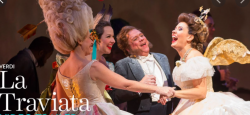Special Trash Talk: Frank Zappa and Opera Chorus. Really.
Pretty much everyone I know sings along with their favorite music. I started singing along with music my folk liked, and then pop stuff, Beach Boys, Beatles, the usual. In the summer of 1966, Frank Zappa and the Mothers of Invention released their first album, Freak Out. I stumbled on it in late 1967, and soon knew all the songs, and bought Absolutely Free and learned those too. They got me through ROTC summer camp, singing a few bars of Plastic People while stupid marching for miles.
Plastic people
Oh, baby, now you’re such a drag.
Or a few bars of Call Any Vegetable.
Call any vegetable
And the chances are good
That a vegetable will respond to you.
After I got out of the Army I bought several more Zappa albums, including Cruising With Ruben and the Jets and Fillmore East — 1971. But then law school and part-time work, and dating, and my time for serious listening shrank to near zero.
And then I met my wife. She loves opera, so we saw every one produced by the excellent opera theater at Indiana University, which has a full-fledged opera venuevivace. The first opera we saw was Wagner’s Parsifal. I saw most of the first tune in each act, and zoned out for the rest. But I went back for more.
Eventually we wound up in Nashville, TN, where some of the leading supporters of the arts established an opera company in the mid-80s. We saw Madama Butterfly, and a couple of more, and then I found myself in the chorus for Il Trovatore, singing in chain mail. tights, dark make-up, and wielding a three-foot long steel broadsword. I was hooked. Not so much on operas per se, but on opera chorus singing.
It’s not like singing in Church Choirs or Symphony Chorus, which I have also done. In those settings, you listen closely to your neighbors and try to blend your voice with theirs. Good technique is a plus, but most amateur choirs are made up of, well, amateurs. In opera chorus singing, you sing with your full voice including vibrato. The blend comes from singing the exact same pitch on the exact same vowel for the exact same length of time. And you do it from muscle memory, singing near the top of your power, while moving, bending, swinging a heavy sword, riding a ten-foot tall barrel wheeled by your comrades, dancing, or, sadly, just standing and singing, which we call park and bark.
What’s the connection to Zappa? As I see it, opera treats the human voice as a primary instrument. The operatic voice is a trained instrument, capable of a wide range of timbre, power, and expression. Operas are spectacles, with sets, costumes, orchestra, and driven by over-the-top emotions. The voices are the critical part of the spectacle, carrying the emotions up. And that’s just like Zappa’s music: spectacular, relentless, and full of emotion, mostly anger, but also ribald or just fun, and the human voice is a critical part of that emotional ride.
Many of his songs feature his band singing instrumental tunes or making vocal noises. On Absolutely Free, you can here a typical bits in several pieces, both sung with words and with vocal sounds. Here’s a short example, Amnesia Vivace. On Fillmore East — 1971 the group performs what amounts to a smutty opera in the extended piece Mud Shark. Bwana Dik is a full-fledged if short aria; it’s at 14:55 here. Zappa had recruited three former members of The Turtles, and they were real singers. Here’s a very strange bit, John Lennon and Yoko Ono join Zappa and the Mothers of Invention starting at about 1:30, featuring Ono shrieking like a hungry cat while Lennon sings a mindless song backed by the Mothers, who put in their own odd vocal bits especially at about 6:50.
To illustrate the difference between chorus singing and opera singing, here are performances of perhaps the most famous operatic chorus song, Va Pensiero, from Verdi’s Nabucco. (Translation.) First is a performance by the chorus of the Teatro Al Fenice in Venice in concert. Compare it to this performance by the Metropolitan Opera Chorus. And for good measure, here’s a Zoom performance in commemoration of Italy’s losses to Covid-19.
One of the main functions of opera choruses is to provide some life to what might otherwise be static. For example, in a typical production of Wagner’s Flying Dutchman, when the baritone meets the soprano, they stand on opposite sides of the stage and sing for about 20 minutes. But the opening of Act 3 is thrilling to sing, and the chorus is asked to perform a standard role, the drunken sailor.
One of my favorites is Brindisi from Verdi’s La Traviata. The chorus is clearly part of the action, attending a fancy dress party. They sing two choruses, and then sing an instrument-like accompanying part at the end.
One more: this is from Act 1 of Puccini’s Turandot. It demonstrates the difficulty of singing opera chorus. Maintaining sound quality while moving, waving your arms, dropping to the floor and then trying to find the conductor because the orchestration is absolutely not helping is hard. Perhaps you can imagine the pleasure that comes from singing these songs with your friends.
So what’s your favorite sing-along music? It’s Trash Talk so don’t be shy about your jonesing for Tom Jones!

